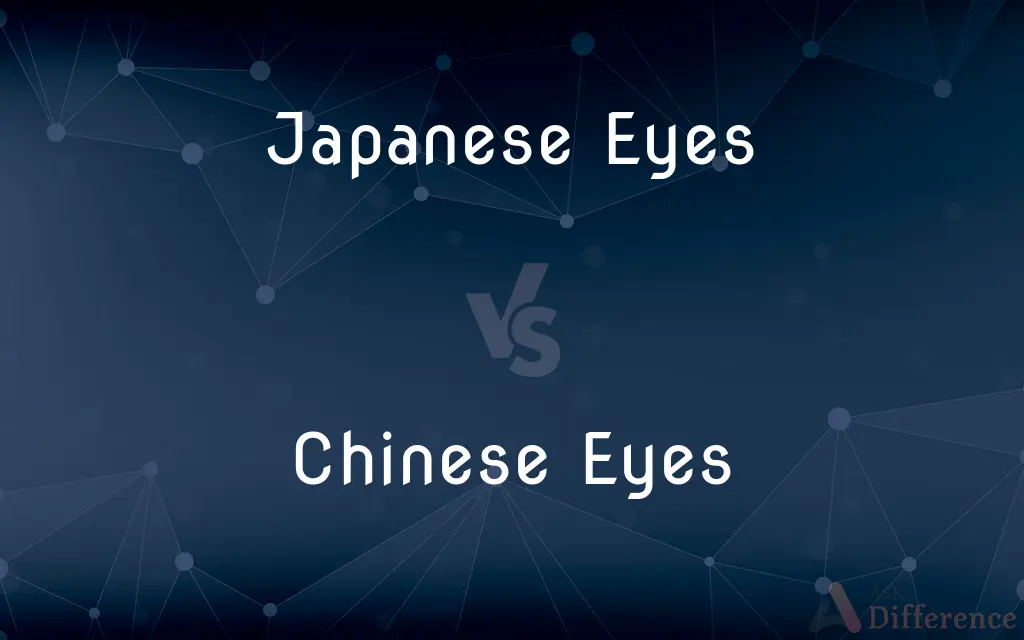Japanese Eyes vs. Chinese Eyes — What's the Difference?
By Tayyaba Rehman — Published on October 24, 2023
Japanese Eyes and Chinese Eyes refer to generalized, and often stereotypical, characteristics of the eyes of people from these regions, though vast individual differences exist within each nationality.

Difference Between Japanese Eyes and Chinese Eyes
Table of Contents
ADVERTISEMENT
Key Differences
Japanese Eyes are often thought to be characterized by their almond shape and a variety of eyelid types.
Chinese Eyes, while also almond-shaped for many, may have a pronounced epicanthic fold for some individuals. However, it's essential to note that describing someone's eyes based on ethnicity can lead to broad generalizations and overlook the rich diversity within each population.
For instance, not all Japanese individuals have the so-called "double eyelids," and not all Chinese individuals have "single eyelids." Moreover, modern-day Japan and China are melting pots of ethnicities and genetics, so the concept of Japanese Eyes or Chinese Eyes being distinctly different is a misconception.
Conclusively, while certain generalized characteristics are associated with Japanese Eyes and Chinese Eyes, individual variation is vast, and any attempt to strictly classify them is an oversimplification.
Comparison Chart
General Shape
Often almond-shaped
Typically almond-shaped
ADVERTISEMENT
Epicanthic Fold
Varies widely among individuals
Some individuals have a pronounced fold
Double Eyelid
Present in some individuals
Less common but exists
Stereotypical Assumptions
Sometimes seen as wider
Sometimes seen as narrower
Individual Variation
High
High
Compare with Definitions
Japanese Eyes
Japanese Eyes are thought to be almond-shaped for many.
She noticed the almond shape of Japanese Eyes in the artwork.
Chinese Eyes
Chinese Eyes are celebrated in various art forms.
Traditional paintings often accentuate the features of Chinese Eyes.
Japanese Eyes
Japanese Eyes are sometimes associated with cultural expressions.
In anime, exaggerated features of Japanese Eyes are often used for stylistic purposes.
Chinese Eyes
Chinese Eyes are often almond-shaped.
The portrait captured the beauty of almond-shaped Chinese Eyes.
Japanese Eyes
Japanese Eyes reflect the nation's genetic diversity.
Traveling across Japan, one can see the vast variation in Japanese Eyes.
Chinese Eyes
Chinese Eyes reflect China's vast genetic and ethnic diversity.
From north to south, the variety in Chinese Eyes is evident.
Japanese Eyes
Japanese Eyes can possess either single or double eyelids.
Her Japanese Eyes had a prominent double eyelid.
Chinese Eyes
Chinese Eyes might display a pronounced epicanthic fold in some individuals.
His Chinese Eyes had a distinct epicanthic fold.
Japanese Eyes
Japanese Eyes are a subject in various forms of art.
The painting beautifully depicted the intricacies of Japanese Eyes.
Chinese Eyes
Chinese Eyes can be both single and double eyelids.
Her Chinese Eyes had a rare double eyelid feature.
Common Curiosities
Is it accurate to determine nationality based on eyes?
No, it's an oversimplification and can lead to incorrect assumptions.
Are there surgeries to modify Japanese Eyes or Chinese Eyes?
Yes, surgeries like blepharoplasty can modify eyelids, but reasons vary from medical to cosmetic.
Can you find single and double eyelids in both Japanese and Chinese populations?
Yes, both features can be found in individuals from both nationalities.
Are Japanese Eyes and Chinese Eyes used as terms in scientific studies?
Scientific studies focus on genetic variations and traits, rather than broad and generalized terms.
Are all Japanese Eyes and Chinese Eyes the same?
No, there's a vast individual variation in eye features within both nationalities.
Do all Chinese Eyes have a pronounced epicanthic fold?
No, while some Chinese individuals might have a pronounced fold, others do not.
Is the color of the iris the same for Japanese Eyes and Chinese Eyes?
Eye color varies among individuals, but brown is predominant in both populations.
Are double eyelids common in Japanese Eyes?
Some Japanese individuals have double eyelids, but it's not universal.
Why is there a focus on Japanese Eyes and Chinese Eyes in art?
Eyes are expressive and culturally significant in many art forms.
Are the terms Japanese Eyes and Chinese Eyes considered offensive?
Using these terms can lead to broad generalizations, and in some contexts, they can be viewed as stereotypical or offensive.
Do Japanese Eyes and Chinese Eyes have any cultural significance in their respective countries?
Yes, eyes have cultural, aesthetic, and sometimes spiritual significance in many cultures.
How have perceptions of Japanese Eyes and Chinese Eyes changed over time?
Perceptions have evolved due to globalization, cultural exchange, and increasing awareness against stereotypes.
How do genetics play a role in the features of Japanese Eyes and Chinese Eyes?
Genetics influence all physical traits, but regional genetic variations are nuanced and complex.
Are there specific makeup techniques for Japanese Eyes or Chinese Eyes?
Different eye shapes might have tailored makeup techniques, but it's based on individual features rather than nationality.
Is there a difference in vision or visual health between Japanese Eyes and Chinese Eyes?
Eye shape doesn't dictate vision quality; visual health varies based on individual genetics and environmental factors.
Share Your Discovery

Previous Comparison
Factors vs. Multiples
Next Comparison
Have Been vs. Had BeenAuthor Spotlight
Written by
Tayyaba RehmanTayyaba Rehman is a distinguished writer, currently serving as a primary contributor to askdifference.com. As a researcher in semantics and etymology, Tayyaba's passion for the complexity of languages and their distinctions has found a perfect home on the platform. Tayyaba delves into the intricacies of language, distinguishing between commonly confused words and phrases, thereby providing clarity for readers worldwide.
















































